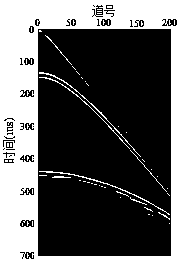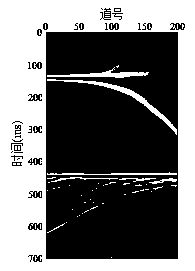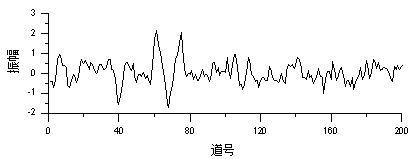Method for separating seismic diffraction waves by median resistance filtering
A diffracted wave and earthquake technology, applied in the field of seismic data processing, can solve problems such as weak diffracted wave energy, and achieve the effect of improving prediction accuracy
- Summary
- Abstract
- Description
- Claims
- Application Information
AI Technical Summary
Problems solved by technology
Method used
Image
Examples
Embodiment
[0060] Taking a set of coal mine subsidence column detection seismic data with 101 shots, 200 traces per shot, 700 sampling points per trace, a trace distance of 5m, and a sampling rate of 1ms as an example to illustrate the implementation steps:
[0061] Step 1: Read single-shot seismic data containing 200 traces, each with 700 sampling points, into a two-dimensional array R 1 in, see figure 1 ;
[0062] Step 2: According to the superposition speed of reflected wave and the time distance of reflected wave, the two-dimensional array R 1 Perform normal time difference correction processing to obtain an array R 2 , see figure 2 ;
[0063] The equation for determining the normal time difference of reflected waves:
[0064] Among them, △ t is the normal time difference of the reflected wave, x is the offset, t is an offset of x when traveling, t 0 is the travel time in the case of zero offset, v is the superposition velocity of the reflected wave;
[0065] Step ...
PUM
 Login to View More
Login to View More Abstract
Description
Claims
Application Information
 Login to View More
Login to View More - R&D
- Intellectual Property
- Life Sciences
- Materials
- Tech Scout
- Unparalleled Data Quality
- Higher Quality Content
- 60% Fewer Hallucinations
Browse by: Latest US Patents, China's latest patents, Technical Efficacy Thesaurus, Application Domain, Technology Topic, Popular Technical Reports.
© 2025 PatSnap. All rights reserved.Legal|Privacy policy|Modern Slavery Act Transparency Statement|Sitemap|About US| Contact US: help@patsnap.com



